How to connect a two-way switch - schematic
A large number of light switches in various designs and uses are available for the home. Many customers have questions about the function, principle of operation and wiring diagram of the so-called loop-through switches. Below is a description of the differences between such devices and conventional devices, as well as the use of such appliances to control lighting.
The structure of the passthrough switch and the difference from other types
Externally, the walk-through switch does not differ from the household apparatus designed to control the light. It is equipped with one, two or three movable keys, each of which has two independent fixed positions. The fundamental difference from conventional switching devices is in the design of the contact group. If at the standard device for each key has one pair of contacts on the make-open circuit, but at the feed-through switch each sliding panel controls the flip-over contact group. In one position one circuit is closed, in the other position another is closed. In fact, such a device is a switch.
The 2-button switch has two contact groups that can be controlled independently. The three-key switch has three. In order to distinguish a two-way device from a normal device, it is often marked in the form of arrows or a symbolic indication of a staircase.
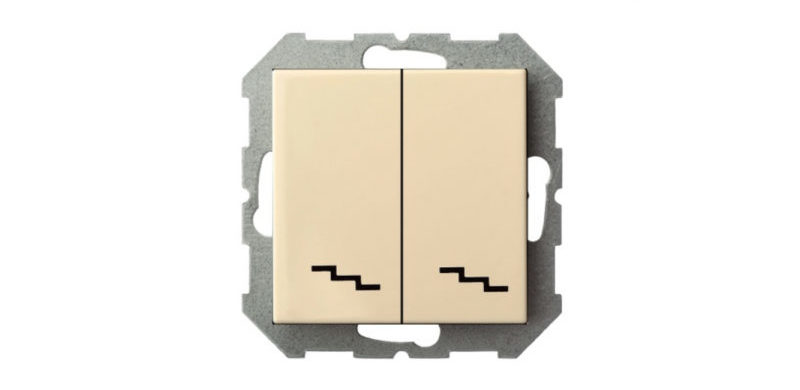
Important! It should not be confused with the cross switches. Such switching devices also have a system of contacts for switching. The difference of crossing devices from two-key-through that at the first one button simultaneously control two change-over contact groups. Another difference is in the internal circuitry. Normally open (normally open, NO) and normally closed (normally closed, NC) contacts of each pair of such devices are cross-connected. Such devices are also used in lighting control circuits with three or more points.
According to the execution of the devices can be:
- overhead (for open and concealed wiring);
- Built-in (for concealed wiring).
There are also sensor switches, but they cost more. In addition, most users agree that they are less convenient.
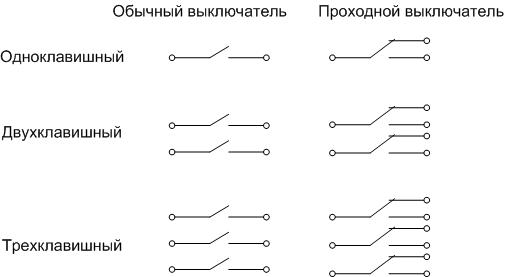
General wiring diagram
Such a switch can be used to control the lighting load (lamps) - one, two or three, depending on the number of keys.
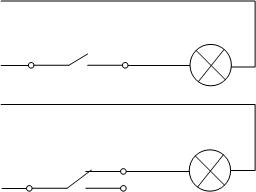
With this connection, one contact is left unused. But it is not economically feasible to use this way - they are a little more expensive than standard devices. The usual application of such devices is control circuits for light bulbs from different points.

Such a connection allows each apparatus to control the switching on and off of the light bulb, regardless of the state of the second. In practice, this principle can be used, for example, for lighting in long tunnels and corridors .. At the beginning of the passage the lights can be switched on, and when walking to the exit they can be switched off. The next person to come in can do the same thing again, regardless of the position of the switching devices and regardless of the direction of travel.
Where the devices are used
Having two devices with two buttons each, you can arrange independent control of two lights from two points. Such a scheme of connection of the two-way switch can be used, for example, in a warehouse with two zones or in a long corridor with a turn of 90 degrees, if one group of lights can not illuminate both areas. Another option is large rooms with a double lighting system (spot and general), as well as two-story houses.
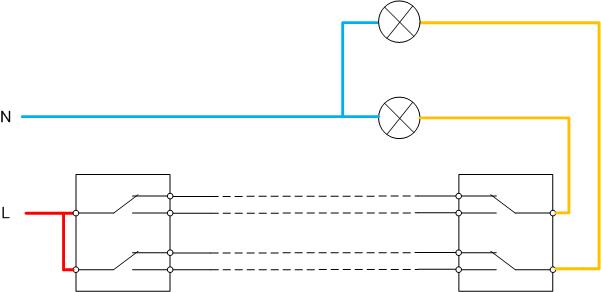
With this connection, each lamp (or group of lamps) can be switched from two points independently.
Practical implementation of the double-through circuit
The dual gang-array circuit described above can be implemented in practice in different ways. The choice depends on the local conditions and is made for reasons of installation convenience and economics.
Connection via a junction box
If the junction box to which you intend to connect a two-way two-way switch is located approximately midway between the entrance and exit aisle, you can apply the following wiring scheme:
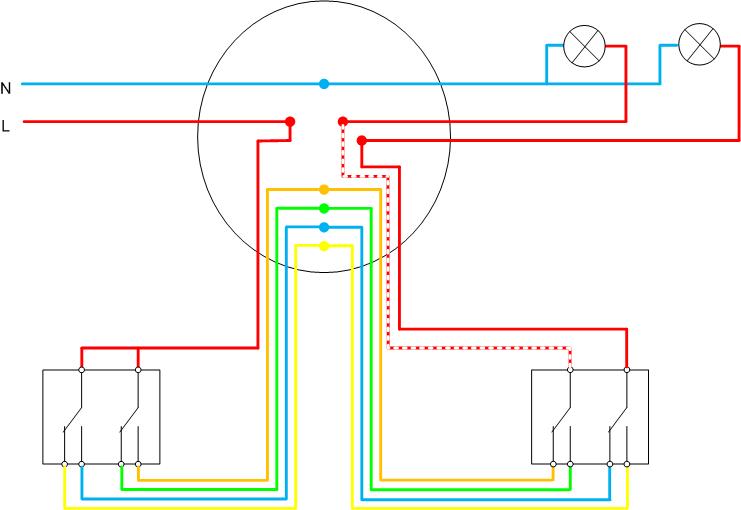
In this case, you will need a cable:
- A five-core cable to connect the first circuit breaker;
- six-core cable to connect the second switching device (its change-over contacts are connected separately and an additional conductor is required).
The cables are laid from the place where the switches are installed to the junction box, where the wires are disconnected. Obviously, the scheme turns out to be quite cumbersome, and when installation It is necessary to ensure the correctness of the connection. To greatly facilitate the work, minimize the probability of error and avoid the tedious and time-consuming part of the work of wire-calling will allow the use of cables with different-colored insulation or with the numbering applied along the entire length of the conductors. In order to do the installation correctly, you should be guided by the internal diagram of the device, printed on the back.
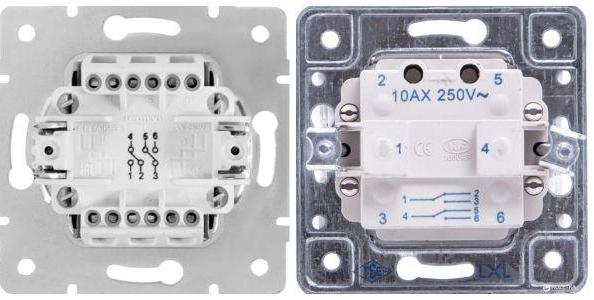
Another variant of marking is symbolic:
- L1 or L2 are changeover contacts for the first and second groups respectively;
- an arrow with a number indicates normally open and normally closed contacts.
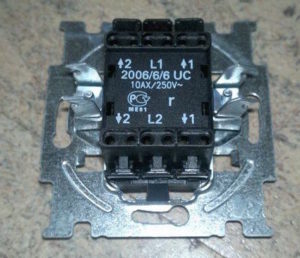
To avoid mistakes, you can draw a sketch of the circuit on a piece of paper (using colored markers) or on a computer with the correct color markings. If the switch terminals are labeled with symbols, they should also be labeled on the sketch. This will prevent confusion about the terminals. The connected circuit can be marked on the drawing. This will further reduce the chance of error.
This type of connection involves a lot of connections of conductors. In a standard switch box with a diameter of 60 mm is difficult to arrange such a number of wires and connectors. It is desirable to buy a box with a larger diameter.
Such a scheme is used in most cases in conjunction with concealed wiring. Its laying involves cutting through the walls and the arrangement of recesses for the installation of electrical outlets for switches - usually chosen devices with flush mounting.
Cable cross-section is selected on the basis of the load capacity. Many years of experience in installing lighting systems, we can say that the copper cable cross section 1.5 mm² enough for virtually all cases. And the widespread use of LED lighting gives no reason to increase this value. But in this case another parameter is important. The length of electrical lines can turn out to be significant, and the voltage drop on the wiring can be significant. It is better to perform a check on this parameter before starting the installation. It is most convenient to do this with the help of online calculators. If less than 95% of the input voltage reaches the consumers, the cross-section should be increased by one step and checked again for losses.
Video lesson: Detail about lighting control from 2 places.
Daisy-chain connection
In some cases, it may be best to connect without a wiring box. This circuit will require a cable with a maximum of five conductors (or even four if the neutral wire is not in a common sheath, but over the shortest distance). This is more advantageous from an economic point of view. Also in this variant it is easier to install due to the use of thinner cable - it takes up less space in boxes and allows smaller bending radii. In this case, it is also highly recommended to use cable products with marked cores - it will greatly facilitate the work and reduce the chance of error.
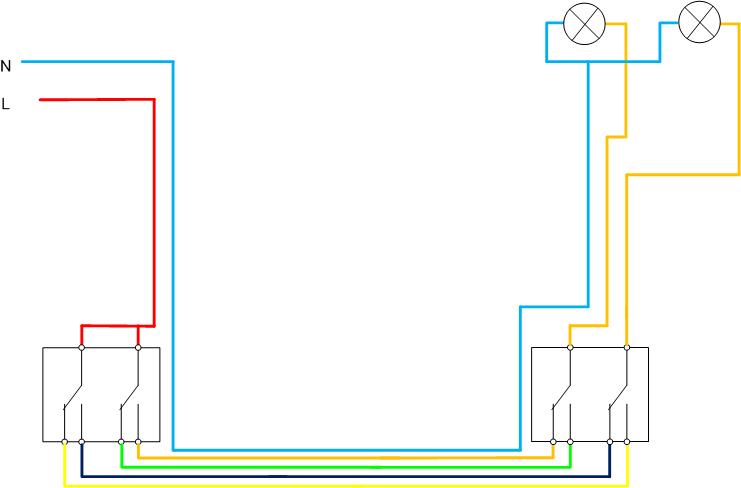
If you choose this topology of laying the neutral conductor, you will also need a two-core cable to bring the supply voltage of 220 volts to the first switching device, and a three-core cable to connect the two groups of lights.
| Cable name | Number of wires | Cross section, sq.mm | Conductor material | Other properties |
| VVG 2x1,5 | 2 | 1,5 | copper | |
| VVGp - NH 2х1,5 | 2 | 1,5 | copper | Non-combustible |
| VVGp - NG 3x1,5 | 3 | 1,5 | copper | Non-combustible |
| VVGp - NG 5x1,5 | 5 | 1,5 | copper | Non-combustible |
| NYM 5x1,5 | 5 | 1,5 | copper | Non-combustible |
| VVG 6x1.5 | 6 | 1,5 | copper | |
| VVG-NG-LSx1,5 | 7 | 1,5 | copper | Non-combustible with low smoke formation |
The table shows some brands of domestic and imported cables, which can be used when installing a lighting control system.
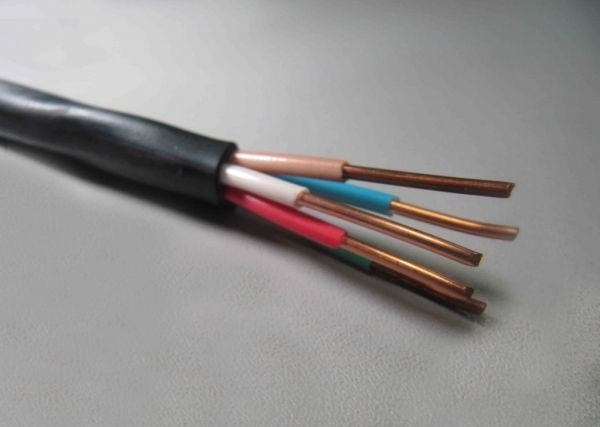
Loop topology is convenient to use in open wiring with the installation of overhead devices. But there are no fundamental prohibitions on the arrangement of hidden wiring.
The video clearly demonstrates the installation of a two-key loop-through switch.
Two-way switch with two buttons allows you to organize independent switching of two lights from two or more (with the use of additional elements) places. This gives not only convenience, but also a noticeable energy saving by minimizing the turn-on time of the lamps. Connecting such a system yourself is not difficult.